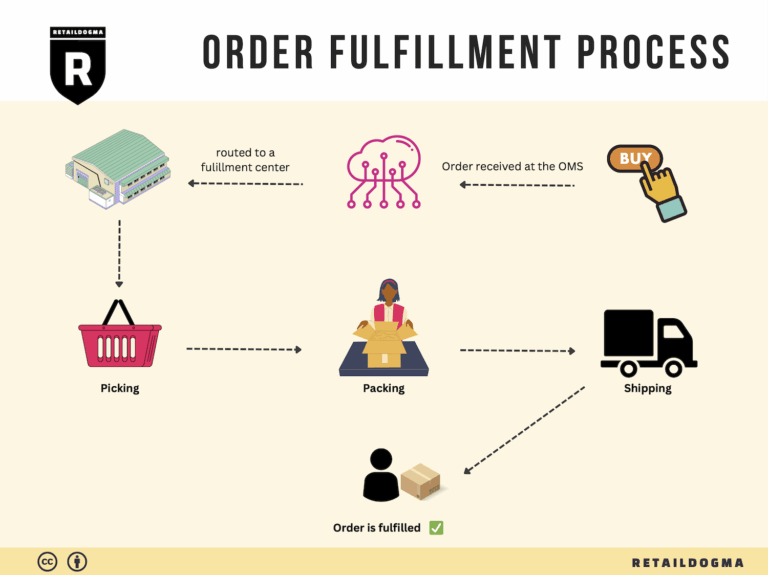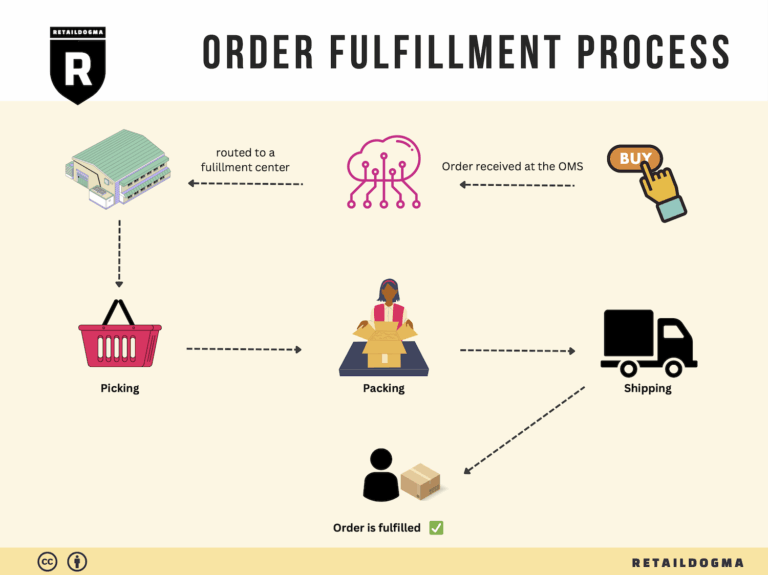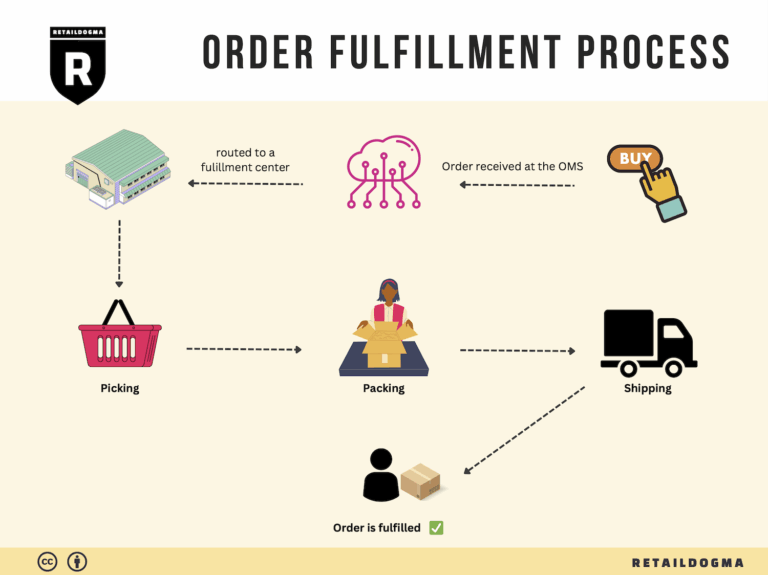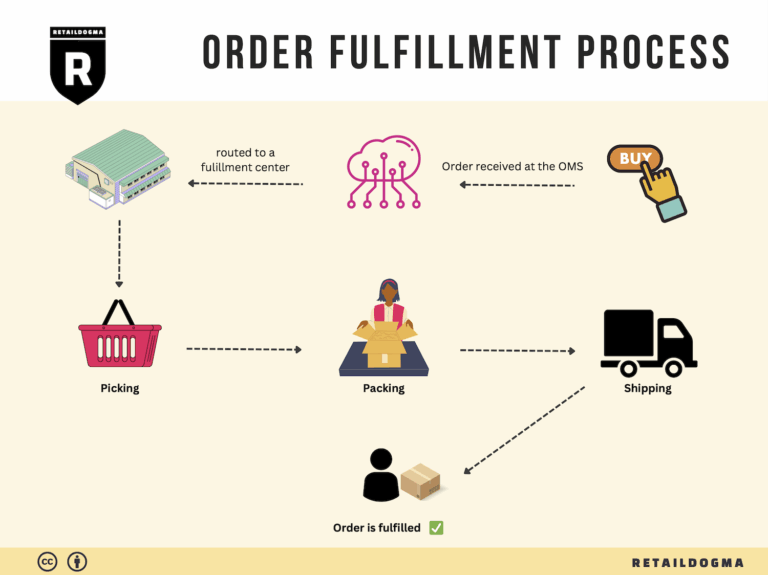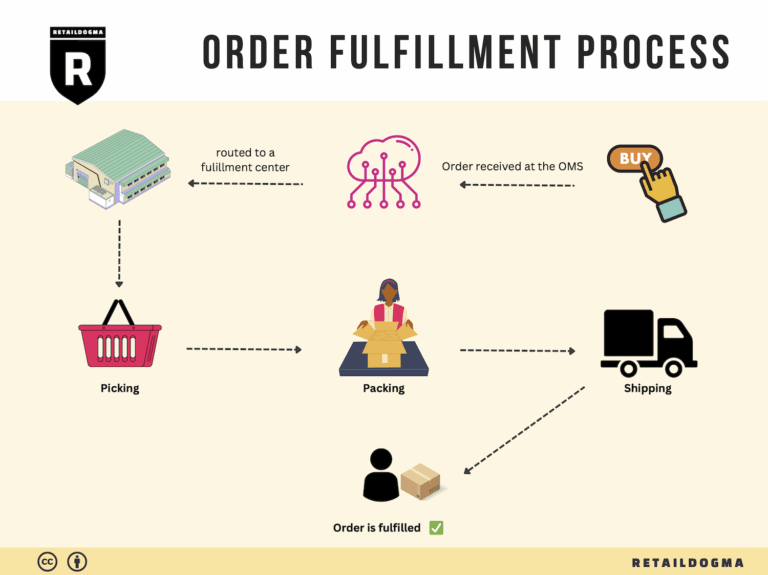What Is A Fulfillment Center? A Complete Guide (2025)
What is E-commerce Fulfillment? An Introduction for Growing Businesses
Understanding E-commerce Fulfillment: A Key to Growth
As an e-commerce business owner, one of the most common challenges you face is managing the logistics of packing and shipping orders. The excitement of growing sales can quickly turn into overwhelming stress when you find yourself buried under a mountain of boxes, packing tape, and shipping labels. This is where e-commerce fulfillment comes into play.
Fulfillment is fundamentally the process of getting a product from your warehouse or storage facility to your customer’s doorstep. It encompasses everything from inventory management to order processing and shipping logistics. For growing businesses, understanding and optimizing this process is crucial not only for operational efficiency but also for enhancing customer satisfaction.
In this guide, we will explore various fulfillment models, including Third-Party Logistics (3PL) and Fulfillment by Amazon (FBA), to help you determine which option aligns best with your business needs. We will break down the core services involved in e-commerce fulfillment, such as inventory storage, order picking, packing, and shipping. Each of these components plays a significant role in ensuring that your customers receive their orders promptly and accurately.
Choosing the right fulfillment partner can make or break your e-commerce business. We will provide insights into what to look for in a logistics partner, including factors such as order accuracy, shipping speed, and customer service. Additionally, we will cover pricing structures, so you can make informed decisions that balance cost with service quality.
The goal of this guide is to empower you with the knowledge necessary to make smart decisions about your logistics strategy. By understanding the intricacies of e-commerce fulfillment, you can streamline your operations, reduce costs, and ultimately scale your business more effectively. With the right fulfillment approach in place, you can focus on what you do best—growing your brand and serving your customers.
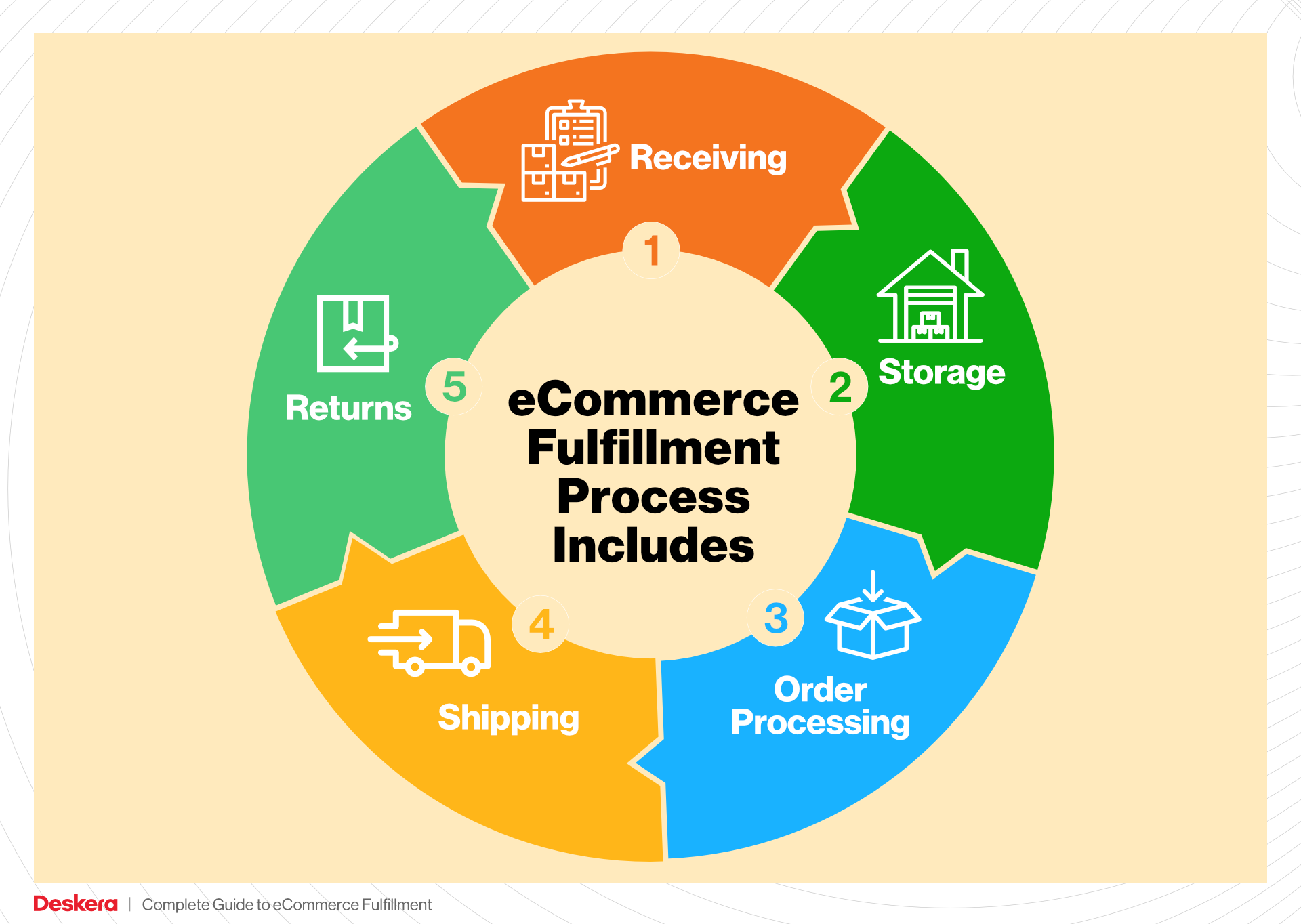
Let’s dive into the world of e-commerce fulfillment and discover how you can enhance your logistics operations for sustainable growth.
What You’ll Learn In This Guide
- What is E-commerce Fulfillment? An Introduction for Growing Businesses
- The Order Fulfillment Process: From ‘Buy’ Button to Customer’s Door
- Comparing Fulfillment Models: In-House vs. 3PL vs. Dropshipping
- A Deep Dive into Amazon FBA: Pros, Cons, and Who It’s For
- Core Services Offered by Fulfillment Centers
- How to Choose a Fulfillment Partner: A 6-Point Checklist
- Understanding Fulfillment Pricing: A Breakdown of Common Fees
- Frequently Asked Questions (FAQs) about Fulfillment
- Conclusion: Is Outsourcing Fulfillment the Right Move for Your Business?
- Important Disclaimer
The Order Fulfillment Process: From ‘Buy’ Button to Customer’s Door
1. Receiving Inventory
The order fulfillment process begins with receiving inventory from suppliers or manufacturers. This step is crucial as it sets the foundation for all subsequent activities. When inventory arrives at your fulfillment center, it undergoes a thorough inspection to ensure that the correct products and quantities have been delivered. This process often involves the use of Stock Keeping Units (SKUs), which are unique identifiers for each product.
Proper inventory receiving helps prevent discrepancies and ensures that your stock levels are accurate, which is vital for maintaining customer satisfaction and optimizing your supply chain. High accuracy in this phase leads to fewer errors later on, reducing the risk of stockouts or overstocking. Implementing a robust receiving process can significantly improve your operational efficiency and contribute to a higher order accuracy rate, which is essential for building customer trust.
2. Warehouse Storage
Once inventory has been received and verified, the next step is warehouse storage. This process involves organizing the products in a manner that maximizes space and facilitates easy access. Efficient storage solutions can include shelving, bins, or pallet racking systems tailored to the size and type of products being stored.
Effective warehouse storage is important because it directly impacts order picking speed and accuracy. Utilizing inventory management systems, such as a Warehouse Management System (WMS), can help track stock levels and product locations, enabling quick retrieval when orders are placed. By optimizing storage layouts and maintaining accurate inventory records, businesses can reduce operational costs and improve order fulfillment speed, ultimately enhancing the customer experience.
3. Order Picking
Order picking is the process where items are selected from their storage locations to fulfill customer orders. This step is critical as it directly affects the order accuracy and overall fulfillment speed. Businesses often use pick lists—documents that outline the items and quantities needed for each order—to guide the picking process.
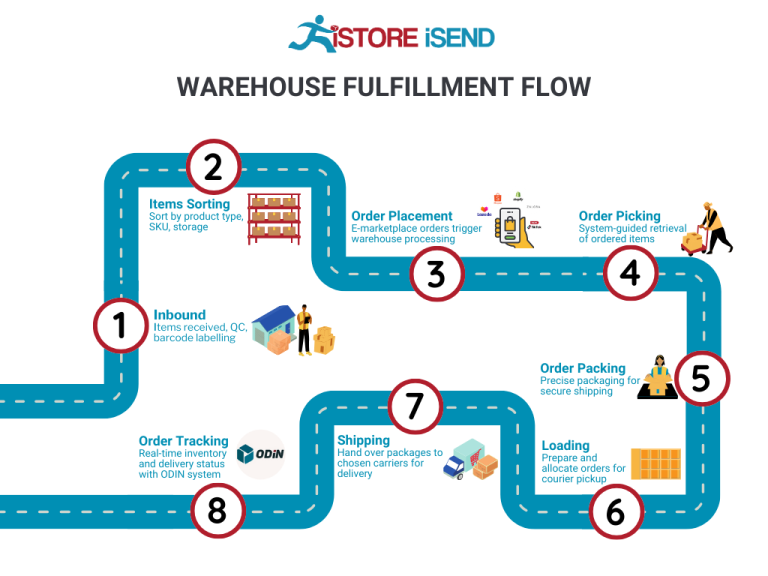
There are several picking methods, including single order picking, batch picking, and wave picking, each suited for different operational scales and types of orders. The choice of picking method can influence efficiency; for instance, batch picking can reduce travel time in the warehouse when fulfilling multiple orders simultaneously. Improving the picking process can lead to significant reductions in labor costs and faster order processing times, which are essential for maintaining a competitive edge in e-commerce.
4. Order Packing
After items have been picked, they move to the packing stage. This step involves securely packaging the products to ensure they arrive at the customer’s door in perfect condition. Proper packing is essential not only for protecting the items during transit but also for creating a positive unboxing experience for customers.
In this phase, businesses often utilize packing slips, which provide information about the contents of the package, and may include branding elements to enhance the customer’s experience. Choosing the right packaging materials is also vital; using eco-friendly options can appeal to environmentally conscious consumers. Efficient packing processes can lead to lower shipping costs and reduced return rates, contributing to overall customer satisfaction and loyalty.
5. Shipping & Delivery
The final step in the order fulfillment process is shipping and delivery. This phase involves selecting the appropriate carrier and shipping method to get the package to the customer as quickly and cost-effectively as possible. Businesses often rely on shipping management software to compare rates from various carriers and choose the best option based on service level agreements (SLAs).
Timely delivery is crucial in e-commerce, as customers increasingly expect fast shipping options, such as two-day delivery. To meet these expectations, businesses can leverage strategic warehouse locations and shipping partnerships to reduce transit times. Additionally, providing customers with tracking information enhances transparency and trust. A streamlined shipping process not only improves customer satisfaction but can also drive repeat purchases and foster brand loyalty.
By understanding and optimizing each of these five steps in the order fulfillment process, e-commerce businesses can effectively scale their operations while delivering exceptional service to their customers. Each phase is interconnected and plays a vital role in ensuring that products move seamlessly from the ‘buy’ button to the customer’s door.
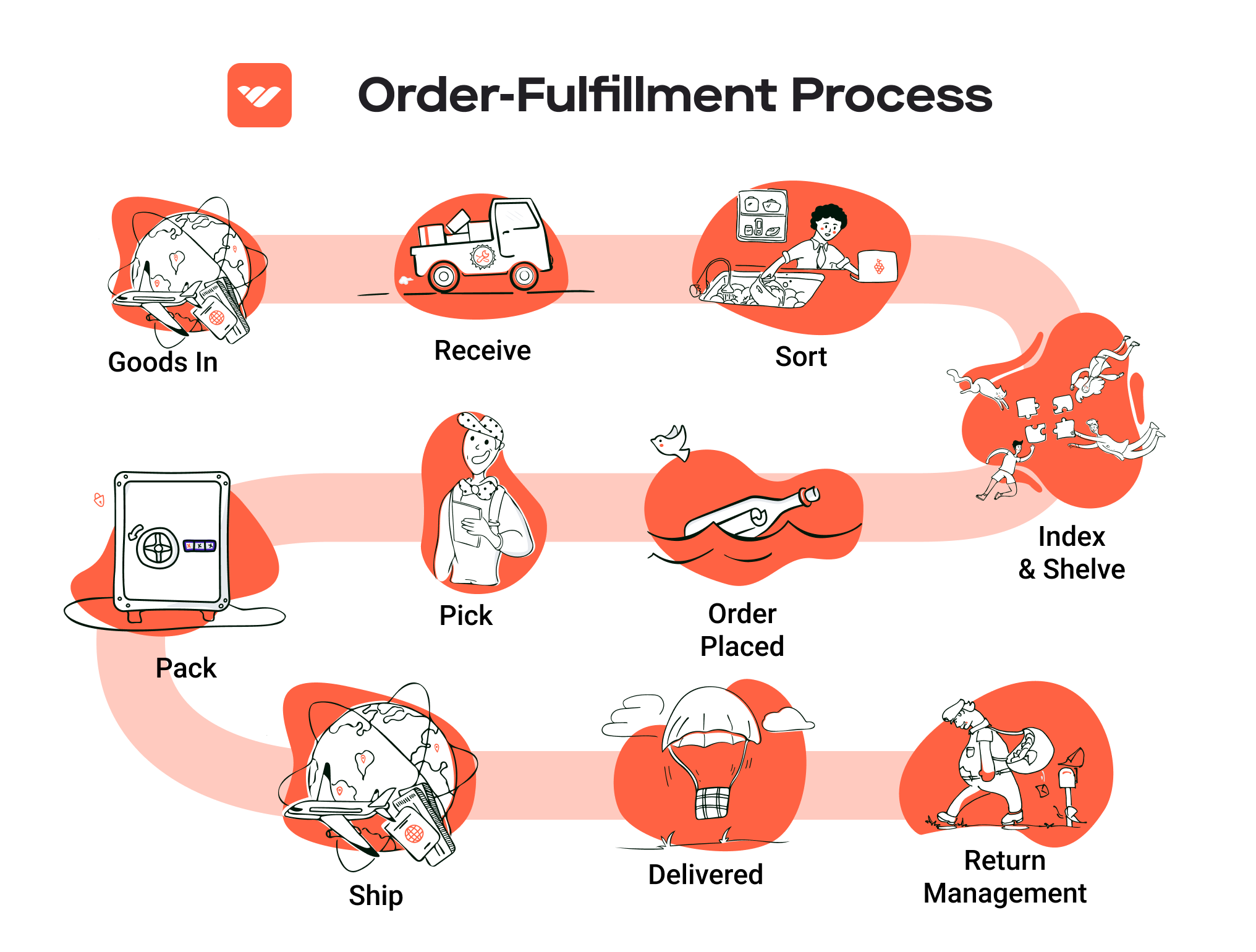
Comparing Fulfillment Models: In-House vs. 3PL vs. Dropshipping
Fulfillment Model Comparison
| Model | Who Handles Inventory | Best For (Business Stage) | Key Advantage | Key Disadvantage |
|---|---|---|---|---|
| In-House Fulfillment | The business itself | Startups to mid-sized businesses | Complete control over inventory and fulfillment | Higher upfront costs and operational complexities |
| Third-Party Logistics (3PL) | 3PL provider | Growth-focused businesses | Scalability and access to expertise | Less control over inventory and potential dependency |
| Dropshipping | Supplier | New entrepreneurs and niche brands | Low startup costs and minimal risk | Lower profit margins and less control over shipping |
In-House Fulfillment
In-house fulfillment involves a business managing its own inventory, storage, and shipping processes. This model is often adopted by startups and mid-sized businesses that seek greater control over their operations. One of the main advantages of in-house fulfillment is the ability to oversee every aspect of the fulfillment process. Businesses can customize packaging, manage stock levels, and ensure quality control, which can enhance customer satisfaction. However, the drawbacks include significant upfront investments in warehousing, staffing, and technology, as well as the complexities of managing logistics. As businesses scale, the operational demands can become overwhelming, necessitating additional resources and expertise.
Third-Party Logistics (3PL)
Third-party logistics (3PL) providers offer outsourced fulfillment services, managing inventory storage, order processing, and shipping on behalf of businesses. This model is particularly beneficial for growth-focused companies looking to scale efficiently. One of the key advantages of partnering with a 3PL is the ability to leverage their expertise and infrastructure. They often have established networks and systems that can reduce shipping costs, improve delivery times, and provide access to advanced technology for inventory management. However, businesses may face challenges such as reduced control over their inventory and fulfillment process, as well as potential dependency on the 3PL’s performance and reliability. Choosing the right partner is crucial, as not all 3PLs offer the same level of service or capabilities.
Dropshipping
Dropshipping is a fulfillment model where the retailer does not hold inventory but instead transfers customer orders directly to a supplier, who then ships the products to the customer. This model is ideal for new entrepreneurs and niche brands looking to minimize startup costs and operational risks. The primary advantage of dropshipping is the low barrier to entry; businesses can launch without the need for significant upfront investments in inventory or storage. However, dropshipping also comes with its own set of challenges. Profit margins can be lower compared to in-house or 3PL models due to the costs associated with suppliers. Additionally, retailers often have less control over shipping times and product quality, which can impact customer satisfaction. As such, it’s essential for dropshippers to select reliable suppliers to mitigate these risks.
Conclusion
When evaluating fulfillment models, e-commerce business owners must consider their current operational capacity, growth objectives, and the level of control they wish to maintain over their supply chain. In-house fulfillment offers complete control but demands significant resources, while 3PLs provide scalability and expertise at the cost of some control. Dropshipping is a low-risk entry point for many entrepreneurs, but it comes with challenges that can affect profitability and customer satisfaction. By understanding these models in detail, businesses can make informed decisions that align with their strategic goals and operational needs.
A Deep Dive into Amazon FBA: Pros, Cons, and Who It’s For
Understanding Fulfillment by Amazon (FBA)
Fulfillment by Amazon (FBA) is a service that enables e-commerce sellers to store their products in Amazon’s fulfillment centers. When a customer makes a purchase, Amazon takes care of storage, packaging, shipping, and customer service. This model allows sellers to leverage Amazon’s extensive logistics network and customer base, streamlining their operations and enhancing their market reach.
How FBA Works
- Account Setup: To use FBA, sellers need to create an Amazon seller account and enable the FBA option.
- Inventory Management: Sellers prepare their products according to Amazon’s guidelines and send them to one or more of Amazon’s fulfillment centers.
- Order Processing: Once the inventory is received and processed, products become available for sale. When a customer places an order, Amazon handles the entire fulfillment process, including picking, packing, and shipping.
- Customer Support: Amazon also manages all customer inquiries and returns, ensuring a seamless experience for buyers.
This system not only simplifies logistics but also allows sellers to scale their operations without the burden of managing warehousing and shipping logistics.
Pros of Fulfillment by Amazon
1. Prime Eligibility
One of the most significant advantages of using FBA is access to Amazon Prime. Products fulfilled by Amazon are eligible for Prime shipping, which offers customers fast, often free shipping. This can significantly increase sales as Prime members tend to favor products with Prime eligibility.
2. Customer Trust
Amazon is a well-established brand known for its customer service and reliability. By using FBA, sellers can benefit from this trust. Customers are more likely to purchase products that are fulfilled by Amazon because they know they can expect fast shipping and efficient returns.
3. Multi-Channel Fulfillment
FBA isn’t just limited to sales on Amazon. Sellers can also use FBA to fulfill orders from other sales channels, such as their own websites or other online marketplaces. This multi-channel fulfillment capability allows sellers to consolidate their logistics and reduce overhead costs.
4. Simplified Logistics
FBA takes the complexity out of logistics. Sellers don’t have to worry about storage space, shipping, or handling returns. This allows them to focus on other aspects of their business, such as marketing and product development.
5. Scalability
As businesses grow, their fulfillment needs can change dramatically. FBA offers a scalable solution that can adapt to increasing inventory and order volumes without requiring significant changes to the seller’s operations.
Cons of Fulfillment by Amazon
1. High Fees
One of the most significant drawbacks of FBA is the cost. Amazon charges various fees, including storage fees, fulfillment fees, and additional charges for long-term storage. For some sellers, these costs can add up quickly, significantly impacting their profit margins.
2. Strict Inventory Rules
Amazon has stringent guidelines regarding inventory management. Sellers must adhere to specific packaging and labeling standards, and any deviation can result in additional fees or inventory being returned. This can be cumbersome for sellers who are not accustomed to such regulations.
3. Commingling Risks
When using FBA, sellers’ products may be stored alongside those of other sellers. This commingling can lead to issues if a customer receives a different product than they ordered. While Amazon offers a solution for this through its “Stickered Inventory” option, it can complicate the fulfillment process.
4. Loss of Control
Using FBA means relinquishing some control over the fulfillment process. Sellers are dependent on Amazon’s systems and processes, which can sometimes lead to errors that impact customer satisfaction.
5. Inventory Limitations
Sellers are often subject to inventory limits, especially if they are new or have not established a strong sales history. These limits can hinder growth, as sellers may not be able to stock enough inventory to meet demand.
Who is FBA Best For?
FBA is an excellent choice for e-commerce businesses looking to scale their operations without the complexities of managing logistics. It is particularly beneficial for:
- Small to Medium-Sized Businesses: Companies that lack the resources to manage their own warehousing and shipping can leverage FBA to streamline operations.
- Brands Seeking to Increase Visibility: Sellers aiming to tap into Amazon’s vast customer base and benefit from Prime eligibility will find FBA advantageous.
- Multi-Channel Sellers: Businesses that sell across multiple platforms can simplify their fulfillment processes by using FBA for all orders.
- Businesses with Seasonal Demand: Companies that experience fluctuating demand can benefit from the scalability of FBA, allowing them to adjust inventory levels without the risk of overextending themselves.
In conclusion, while Fulfillment by Amazon offers numerous advantages, it is crucial for sellers to weigh these against the potential drawbacks. Understanding the implications of FBA can help businesses make informed decisions about their fulfillment strategies, ultimately enhancing their operational efficiency and customer satisfaction.
Core Services Offered by Fulfillment Centers
Inventory Management & Warehousing
Inventory management and warehousing are foundational services provided by fulfillment centers that allow e-commerce businesses to effectively track and store their products. Fulfillment centers utilize sophisticated Warehouse Management Systems (WMS) to monitor inventory levels in real-time, ensuring that stock is available and accounted for. This service typically includes receiving inventory, organizing products in a way that optimizes space and accessibility, and conducting regular audits to maintain accuracy.
Benefits:
1. Real-Time Visibility: E-commerce businesses gain access to real-time data regarding their inventory levels, which aids in making informed decisions about reordering and stock management. This minimizes the risk of stockouts or overstocking, both of which can negatively impact cash flow.
-
Space Optimization: By leveraging a fulfillment center’s warehouse space, businesses can avoid the overhead costs associated with maintaining their own storage facilities. This is particularly beneficial for startups and small businesses that may not have the capital to invest in large warehouses.
-
Scalability: As businesses grow, fulfillment centers can quickly adapt to increased inventory needs without the need for significant capital investments. This flexibility allows companies to scale operations in line with demand without the stress of managing logistics themselves.
Pick and Pack Services
Pick and pack services are essential for efficiently preparing orders for shipment. This process involves selecting the ordered items from the warehouse (picking) and then packaging them for delivery (packing). Fulfillment centers employ trained staff and automated systems to ensure that orders are fulfilled accurately and promptly.
Benefits:
1. Speed and Accuracy: With a dedicated team focused on order fulfillment, businesses can expect quick turnaround times, often shipping orders within 24 hours. High accuracy rates in order picking reduce the risk of returns and enhance customer satisfaction.
-
Custom Packaging Options: Fulfillment centers often offer a variety of packaging solutions that can be tailored to a business’s branding. This creates a cohesive brand experience for customers and can enhance the unboxing experience, leading to repeat purchases.
-
Resource Efficiency: By outsourcing pick and pack services, businesses can free up their internal resources to focus on core activities such as marketing and product development. This efficiency can lead to overall growth and increased revenue.
Kitting and Assembly
Kitting and assembly involve grouping multiple products into a single package or preparing items for sale. This service is especially useful for businesses that sell product bundles or require assembly before shipping. Fulfillment centers can handle this process, ensuring that items are packaged together correctly and efficiently.
Benefits:
1. Enhanced Product Offerings: Kitting allows businesses to create bundled offers or promotional packages that can drive sales and appeal to customers looking for value. This can differentiate a brand in a competitive market.
-
Time Savings: By outsourcing kitting and assembly tasks, businesses can save time and focus on strategic initiatives. Fulfillment centers have the expertise and resources to execute these tasks quickly and accurately, which is especially beneficial during peak seasons.
-
Quality Control: Fulfillment centers typically have quality control measures in place to ensure that all kitted products meet the business’s standards before shipment. This reduces the likelihood of customer complaints and returns.
Returns Management (Reverse Logistics)
Returns management, or reverse logistics, is a critical service offered by fulfillment centers that involves handling returned products efficiently. This includes processing returns, restocking items, and managing the logistics of getting products back into inventory or disposing of them as necessary.
Benefits:
1. Streamlined Process: A well-organized returns management process can simplify what is often a cumbersome aspect of e-commerce. Fulfillment centers can handle returns quickly, reducing the time and effort required by businesses to process returns themselves.
-
Customer Satisfaction: Efficient handling of returns can significantly enhance customer satisfaction. Quick processing of refunds or exchanges can lead to positive reviews and repeat business, as customers appreciate a hassle-free return experience.
-
Data Insights: Returns management also provides valuable insights into customer behavior and product performance. By analyzing return data, businesses can identify trends, improve product quality, and make more informed decisions about inventory and marketing strategies.
In summary, leveraging the core services of fulfillment centers—inventory management and warehousing, pick and pack services, kitting and assembly, and returns management—can significantly enhance the operational efficiency of e-commerce businesses. By outsourcing these critical logistics functions, businesses can focus on growth and customer engagement while ensuring that their fulfillment processes are handled expertly.
How to Choose a Fulfillment Partner: A 6-Point Checklist
Location & Warehouse Network
The geographical location of your fulfillment partner’s warehouses can significantly impact shipping costs and delivery times. A well-placed warehouse network can help you reach a larger customer base more efficiently.
Key Questions to Ask:
– Where are your warehouses located, and how do these locations align with my target market?
– What is your shipping coverage area? Can you reach 80% of the U.S. within 1-3 days?
– How do you manage inventory across multiple locations to ensure optimal shipping times?
By ensuring your fulfillment partner has strategically located warehouses, you can minimize shipping costs and improve delivery speed, enhancing customer satisfaction.
Technology & Integrations
In today’s fast-paced e-commerce environment, the ability to seamlessly integrate with your existing systems is crucial. A robust technology platform should provide real-time visibility into inventory and orders, enabling efficient management of your supply chain.
Key Questions to Ask:
– What warehouse management system (WMS) do you use, and what features does it offer?
– Can your system integrate with my e-commerce platform, ERP, and other tools I currently use?
– How do you handle inventory tracking and order processing? Is there a mobile app for on-the-go management?
A partner with advanced technology and strong integration capabilities will not only streamline operations but also allow for better data analysis and forecasting.
Specializations (e.g., Cold Storage, Oversized Items)
Depending on your product type, you may require specialized fulfillment services. Whether it’s handling perishable goods, oversized items, or fragile products, it’s essential to partner with a provider that has the necessary expertise.
Key Questions to Ask:
– Do you have experience fulfilling products similar to mine? What specialized services do you offer?
– How do you manage items that require special handling, such as cold storage or fragile goods?
– Can you accommodate seasonal fluctuations in demand for specific products?
Choosing a partner that understands the nuances of your product type can help reduce damage rates and improve customer satisfaction.
Scalability & Capacity
As your business grows, your fulfillment needs will change. It’s crucial to select a partner that can scale with you, offering the capacity and flexibility to meet increased demand without compromising service quality.
Key Questions to Ask:
– How do you accommodate spikes in order volume, such as during peak seasons or promotions?
– What is your capacity for storage and order fulfillment? Can you provide additional space as my business grows?
– How quickly can you implement changes to accommodate my evolving needs?
A scalable partner can help you manage growth effectively, ensuring you can meet customer expectations without delays or service issues.
Pricing and Contracts
Understanding the pricing structure and contract terms of your fulfillment partner is vital for maintaining healthy profit margins. Transparent pricing helps you avoid unexpected costs and plan your budget effectively.
Key Questions to Ask:
– What is your pricing model? Are there additional fees for services like returns, storage, or shipping?
– Can you provide a detailed breakdown of costs, including any volume discounts available?
– What are the contract terms? Is there flexibility for renegotiation or cancellation if my needs change?
Being clear on pricing and contract terms will help you make informed decisions and avoid financial pitfalls.
Customer Support & Reviews
Strong customer support is essential for resolving issues quickly and maintaining smooth operations. Additionally, researching a potential partner’s reputation through reviews and testimonials can provide insights into their reliability and service quality.
Key Questions to Ask:
– What level of customer support do you provide? Is there a dedicated account manager?
– How do you handle issues or discrepancies in orders?
– Can you provide references or case studies from businesses similar to mine?
Selecting a partner with excellent customer support and a positive reputation will enhance your overall fulfillment experience and ensure you have a reliable ally in your growth journey.
Conclusion
Choosing the right fulfillment partner is a critical decision that can influence your e-commerce success. By following this checklist, you’ll be better equipped to evaluate potential partners based on essential factors such as location, technology, specialization, scalability, pricing, and customer support. Taking the time to ask the right questions and assess each partner’s capabilities will help you build a strong foundation for your business’s logistics and fulfillment needs.
Understanding Fulfillment Pricing: A Breakdown of Common Fees
Initial Setup Fees
When partnering with a fulfillment provider, businesses often encounter initial setup fees. These costs are typically associated with onboarding your account and integrating your e-commerce platform with the fulfillment provider’s systems. The fee can vary significantly based on the complexity of the integration and the volume of inventory you plan to manage.
To calculate initial setup fees, fulfillment centers may consider factors such as the number of SKUs (Stock Keeping Units) to be integrated, the level of customization required for your specific needs, and whether additional services like custom branding or unique packaging are requested. It’s essential to discuss these details upfront to avoid unexpected costs later in the process.
Receiving Fees
Receiving fees are incurred when your inventory arrives at the fulfillment center. This fee covers the labor and resources needed to unload, inspect, and catalog your products. It ensures that your items are properly accounted for and stored in the warehouse.
The calculation of receiving fees generally depends on the volume of goods being received and the complexity of the receiving process. For instance, if your products require special handling or inspection, additional charges may apply. It’s advisable to inquire about these fees in advance, especially if you anticipate large shipments or frequent deliveries.
Storage Fees (per pallet/bin)
Storage fees are charged for the space your inventory occupies within the fulfillment center. These fees can be calculated on a per-pallet or per-bin basis, depending on how the warehouse organizes its inventory.
Typically, storage fees are billed monthly and can vary based on factors such as the type of product being stored (e.g., large, bulky items may incur higher fees) and the length of time the products remain in storage. Some fulfillment providers also implement tiered pricing structures, where the cost per pallet decreases as the volume increases. It’s critical to understand how these fees are structured to budget accordingly and minimize costs.
Pick & Pack Fees (per item/order)
Pick and pack fees are charged for the labor involved in retrieving items from storage and preparing them for shipment. This process includes picking the correct items, packing them securely, and labeling them for delivery.
Fulfillment centers typically charge on a per-item or per-order basis. For example, a flat fee may apply for each order processed, along with an additional fee for each item picked. Some providers may offer bundled pricing for larger orders, which can help reduce costs as your order volume increases. To ensure accuracy in your budgeting, ask for detailed breakdowns of these fees based on your expected order sizes and frequencies.
Shipping Fees
Shipping fees are the costs associated with transporting your products from the fulfillment center to your customers. This can include a range of charges, such as carrier fees, fuel surcharges, and handling fees.
Shipping fees are generally calculated based on the weight and dimensions of the package, the destination, and the chosen shipping method (e.g., standard, expedited). Many fulfillment providers negotiate discounted shipping rates with carriers due to their volume of shipments, which can result in lower costs for you. It’s beneficial to discuss these shipping options and potential savings when evaluating fulfillment partners.
Tips for Getting an Accurate Quote
-
Detail Your Needs: Provide potential fulfillment partners with comprehensive information about your business model, expected order volume, product types, and any special handling requirements. This will help them give you a more accurate quote.
-
Request Itemized Pricing: Ask for a breakdown of all potential fees, including setup, receiving, storage, pick & pack, and shipping. Understanding each component will help you better compare different providers.
-
Inquire About Discounts: Many fulfillment centers offer volume-based discounts or promotional rates for new clients. Don’t hesitate to ask if these options are available.
-
Consider Long-Term Relationships: If you expect to scale your business, discuss potential pricing adjustments as your order volume increases. Establishing a long-term partnership can often lead to better rates.
-
Evaluate Additional Services: Look for fulfillment centers that offer complementary services like returns management, inventory management, or international shipping, which can add value beyond just basic fulfillment.
By understanding these common fulfillment pricing models and taking the necessary steps to gather detailed information, you can make informed decisions that align with your business goals and budget.
Frequently Asked Questions (FAQs) about Fulfillment
1. What is product fulfillment?
Product fulfillment refers to the entire process of receiving, storing, picking, packing, and shipping products to customers. This encompasses everything from inventory management to order processing and logistics, ensuring that products reach the end consumer efficiently and accurately.
2. What is a 3PL (Third-Party Logistics)?
A 3PL is a service provider that manages a company’s logistics and supply chain operations. This can include warehousing, transportation, and fulfillment services. By outsourcing these functions to a 3PL, businesses can focus on their core competencies while benefiting from the expertise and technology of the logistics provider.
3. What’s the difference between a warehouse and a fulfillment center?
A warehouse is primarily a storage facility for goods, often focusing on bulk storage and inventory management. In contrast, a fulfillment center specializes in the order fulfillment process, including picking, packing, and shipping products directly to customers. Fulfillment centers are designed to handle high volumes of smaller, individual orders efficiently.
4. How much do fulfillment services cost?
Fulfillment service costs can vary significantly based on factors such as order volume, storage space, and additional services (like kitting or packaging). Generally, costs may include a per-order fee, storage fees per pallet or cubic foot, and shipping costs. It’s advisable to request quotes from multiple providers to compare pricing structures and find a solution that fits your budget.
5. How do I choose the right fulfillment partner?
When selecting a fulfillment partner, consider factors such as their accuracy rates, shipping capabilities, technology integrations, and customer service. Look for a provider with a proven track record in your industry and one that can scale with your business as it grows. Reading customer testimonials and case studies can also provide insights into their reliability and performance.
6. What technologies are used in fulfillment services?
Modern fulfillment services utilize various technologies, including Warehouse Management Systems (WMS), inventory tracking software, and order management systems. These tools help streamline operations, provide real-time visibility into inventory levels, automate order processing, and optimize shipping routes to enhance efficiency.
7. How does order fulfillment impact customer satisfaction?
Order fulfillment is a critical component of customer satisfaction. Fast shipping times, accurate order processing, and reliable delivery can significantly enhance the customer experience. In contrast, delays or errors in fulfillment can lead to dissatisfaction and harm your brand’s reputation. Efficient fulfillment processes are essential for maintaining customer loyalty.
8. Can fulfillment services handle returns?
Yes, most fulfillment service providers offer return management solutions as part of their services. This includes processing returns, restocking items, and handling customer communications. Efficient return management is vital for maintaining customer trust and satisfaction, especially in e-commerce, where return rates can be high.
9. What are the benefits of using a fulfillment service?
Using a fulfillment service can provide numerous benefits, including reduced operational costs, improved order accuracy, faster shipping times, and the ability to scale operations quickly. It also allows businesses to focus on growth and marketing instead of the complexities of logistics and inventory management.
10. How can I integrate my e-commerce platform with a fulfillment service?
Most fulfillment providers offer integrations with popular e-commerce platforms such as Shopify, WooCommerce, and Amazon. These integrations typically allow for seamless synchronization of inventory and order data, ensuring that your fulfillment partner receives real-time updates on stock levels and orders. Check with your chosen provider for specific integration options and support.
Conclusion: Is Outsourcing Fulfillment the Right Move for Your Business?
Evaluating the Benefits of Outsourcing Fulfillment
Outsourcing fulfillment can be a game-changer for e-commerce businesses looking to scale efficiently. By partnering with a reliable fulfillment service, companies can save significant time and resources that would otherwise be spent managing logistics. This allows business owners and operations managers to focus on core activities such as product development, marketing, and customer engagement, which are crucial for growth.
One of the most compelling advantages of using a fulfillment partner is scalability. As your business grows, so do your fulfillment needs. A 3PL (third-party logistics) provider can seamlessly adjust to fluctuations in order volume, helping you avoid the pitfalls of overextending your internal resources. Whether you’re experiencing seasonal spikes or launching new product lines, a capable partner can ensure that your logistics infrastructure keeps pace with your ambitions.
Moreover, leveraging the expertise of a fulfillment service means you benefit from advanced logistics strategies, access to discounted shipping rates, and technological integrations that enhance efficiency. With a partner well-versed in the nuances of e-commerce logistics, your business can achieve higher order accuracy and improved customer satisfaction—key metrics that drive repeat business.
However, the effectiveness of outsourcing fulfillment hinges on selecting the right partner. Not all fulfillment services are created equal; it’s essential to conduct thorough due diligence to find a provider that aligns with your business goals and operational requirements.
Call to Action
As you contemplate whether outsourcing fulfillment is the right move for your business, consider conducting an audit of your current shipping processes. Assess your capacity to handle order volume, the accuracy of your shipments, and customer feedback regarding delivery times. This evaluation will provide insight into whether a fulfillment partner could enhance your operations and support your growth trajectory. Don’t hesitate to explore the possibilities—your next strategic move could be just a conversation away.
Important Disclaimer
⚠️ Important Disclaimer
The information in this guide is for educational purposes. Fulfillment services, pricing, and platform features change frequently. Always conduct your own due diligence and consult with providers directly before making business decisions.

